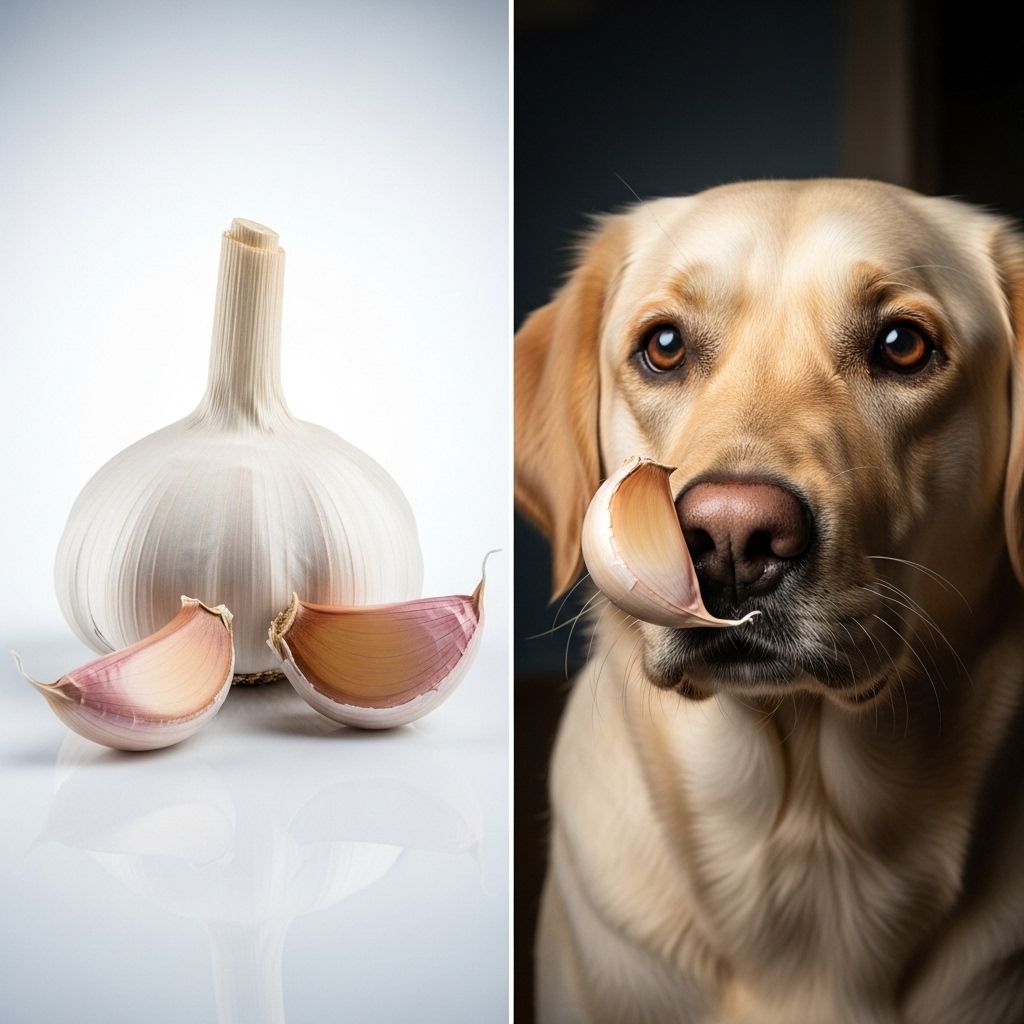Can Dogs Eat Garlic? Comprehensive Guide To Risks And Benefits
Discover surprising facts about canine health and common foods you should avoid feeding pets.

Image: HearthJunction Design Team
Can Dogs Eat Garlic? Risks, Benefits, and What Every Owner Should Know
Garlic is a common kitchen staple, praised for its culinary and health benefits in people. But when it comes to your beloved canine companion, is garlic safe, or could it put your dog at risk? This comprehensive article explores the research, explains the risks and potential benefits of garlic, and offers clear guidance for dog owners seeking the facts about dogs and garlic.
Garlic and Dogs: The Basics
Garlic (Allium sativum) is part of the allium family, which also includes onions, leeks, chives, and shallots. In humans, garlic is celebrated for its health-boosting properties. However, for dogs, garlic contains thiosulfate, a compound that can be toxic to canines but not to humans .
- Allium Family Members: Garlic, onions, leeks, chives, and shallots
- Toxic Compound: Thiosulfate
- Species Affected: Dogs (and cats), not humans
Why Is Garlic Potentially Harmful to Dogs?
Dogs metabolize certain compounds in garlic differently from humans. Thiosulfate, found abundantly in allium vegetables, can damage a dog’s red blood cells, leading to a condition called hemolytic anemia. The destruction of these blood cells reduces the blood’s ability to carry oxygen, causing serious health problems in extreme cases .
How Much Garlic Is Toxic to Dogs?
The level at which garlic becomes toxic to dogs has been widely debated. Recent studies provide a clearer picture:
- Toxicity in dogs generally occurs at 15 to 30 grams of garlic per kilogram of body weight
- A single garlic clove typically weighs between 3 and 7 grams
- Most cases of toxicity are linked to dogs ingesting very large amounts, much more than would typically be found in table scraps or even in homemade dog treats
For context, a 40-pound dog would have to consume about 20 garlic cloves in a day to reach toxic levels according to some studies . The fear of garlic toxicity is largely based on studies where extremely high, unrealistic doses were given to test animals. Moderate, carefully measured use showed no harm and even some benefits .
Symptoms of Garlic Poisoning in Dogs
Garlic poisoning, though rare in the context of normal dietary exposure, can develop if a dog consumes large quantities. Symptoms can take several days to manifest after ingestion. Watch for the following signs:
- Vomiting
- Diarrhea
- Abdominal pain
- Drooling
- Weakness or lethargy
- Pale gums
- Rapid breathing or increased heart rate
- Collapse in severe cases
| Symptom | Description |
|---|---|
| Gastrointestinal upset | Vomiting, diarrhea, abdominal discomfort |
| Hemolytic anemia | Destruction of red blood cells, causing weakness and pale gums |
| Respiratory issues | Rapid or labored breathing in severe cases |
If you suspect your dog has eaten a large amount of garlic or is exhibiting these symptoms, contact your veterinarian immediately .
What to Do If Your Dog Eats Garlic
Immediate action is crucial if your dog has ingested a significant amount of garlic.
- Do not wait for symptoms to appear: Garlic poisoning symptoms may not be immediate.
- Contact your veterinarian or a pet poison hotline: Provide details about your dog’s weight, health status, and estimated amount of garlic consumed.
- Do not induce vomiting unless instructed by a professional.
- Monitor your dog closely for any signs of distress or illness.
Research: Harmful or Helpful?
The conversation about garlic and dogs has been shaped by early studies that linked garlic to toxicity in dogs. However, more recent research has nuanced these findings:
- Extremely high doses (well above any reasonable amount a dog would encounter in daily life) can cause adverse effects, including Heinz body hemolytic anemia .
- Moderate, controlled amounts have not shown harmful effects, and in some cases may provide antioxidant benefits .
- Dogs produce new red blood cells continuously, so moderate exposure to garlic is generally not harmful unless consumed in large quantities over an extended period .
Key Research Findings
| Study | Findings |
|---|---|
| Japanese Study (2000) | Showed toxic effects at high doses (5g/kg/day), leading to anemia. Dogs would need to eat 20 cloves daily! |
| 2018 Controlled Study | Small amounts (90mg/kg) showed no harm, and increased antioxidant activity |
Potential Benefits of Garlic for Dogs
When used judiciously and in very small amounts, some holistic veterinarians and nutritionists argue that garlic can offer genuine benefits to dogs:
- Antioxidant properties: May help reduce oxidative stress and support the immune system
- Natural flea and tick repellent: Some claim garlic can deter external parasites, though evidence is mixed
- Supports cardiovascular health: Mildly helps circulation and heart health
- Detoxification: Garlic is known to help remove toxins from the body
Research suggests that garlic is only harmful to dogs in extremely high doses. Studies indicate that toxicity occurs at 15 to 30 grams per kilogram of a dog’s body weight, yet a single clove of garlic weighs just 3 to 7 grams—far below dangerous levels when fed appropriately. — Grandma Lucy’s Blog
Is Garlic Listed as Safe for Pet Food?
The U.S. Food and Drug Administration (FDA) does list garlic as an approved ingredient in pet food. However, it must be included in safe, controlled amounts, as excessive intake is dangerous .
Safe Practices: Should You Give Your Dog Garlic?
The consensus among mainstream veterinarians is that garlic should be avoided due to the risk of toxicity. However, some holistic practitioners recommend very small, carefully measured amounts for specific health purposes. If you are considering using garlic for your dog, follow these guidelines:
- Always consult a veterinarian first, especially for puppies, pregnant or nursing dogs, or breeds with a predisposition to certain blood disorders.
- Never give garlic in amounts above 15-30 grams per kilogram of your dog’s body weight.
- Monitor closely for any symptoms of gastric upset or behavioral change.
- Never use garlic powder, garlic salt, or concentrated extracts intended for human use.
- If using garlic as part of a commercial dog formula, ensure it is manufactured by a reputable company and follow feeding guidelines strictly.
General Dosage Recommendations from Holistic Sources
| Dog Size | Suggested Max Cloves Per Day |
|---|---|
| Small dogs (up to 20 lbs) | ¼ clove |
| Medium dogs (21–50 lbs) | ½ clove |
| Large dogs (51–90 lbs) | 1 clove |
| Extra large dogs (90+ lbs) | 1½ cloves |
Note: Start with the smallest amount and increase only if no side effects occur. Never start on the full dosage.
Are Some Breeds More Sensitive?
Yes. Certain breeds, such as Akitas and Shiba Inus, may be more susceptible to garlic toxicity due to hereditary differences in their red blood cells. Puppies, elderly dogs, and dogs with pre-existing health problems are also at higher risk. Always check with your veterinarian before giving garlic to these groups.
Prevention: How to Safeguard Your Dog
- Keep garlic bulbs, powders, and tablets out of reach
- Read ingredient labels on snacks and table scraps
- Educate family members about the risks
- Choose commercial dog foods and treats from reputable sources
Frequently Asked Questions (FAQs)
Is cooked garlic safer for dogs than raw garlic?
No. Both cooked and raw garlic contain thiosulfate and can cause toxicity. Cooking does not neutralize the harmful compounds sufficiently to make garlic safe.
Can small amounts of garlic in dog treats harm my dog?
In most cases, trace amounts used in commercial pet treats are far below the toxic threshold, but some dogs may be more sensitive. Always check the ingredient list and consult your veterinarian if unsure.
Are garlic supplements safe for dogs?
Garlic supplements designed for humans should never be given to dogs. Only use supplements or foods specifically formulated for canine use, and always follow veterinary guidance.
What should I do if my dog eats garlic accidentally?
Monitor your dog for symptoms and contact your veterinarian or a pet poison control hotline immediately with details of the quantity and time since ingestion.
Are there safe alternatives to garlic as a flea or tick repellent?
Yes. Look for veterinarian-approved topical or oral flea prevention products. Natural alternatives like brewer’s yeast may be recommended but should also be discussed with your vet.
Conclusion: Is Garlic Ever Safe for Dogs?
Garlic’s reputation as a dangerous food for dogs is rooted in the potential for toxicity when consumed in large, concentrated amounts. Modern research indicates that small, properly measured quantities are unlikely to cause harm—and may even offer health benefits—but the margin for error is very small.
- For most dog owners, it is safest to avoid giving garlic to your pet.
- If you use natural or holistic remedies, consult with a knowledgeable veterinarian for guidance on safe use.
- Always act promptly if ingestion of significant amounts occurs and watch for symptoms of toxicity.
By staying informed and vigilant, you can keep your dog healthy, safe, and happy for years to come.
References
- https://www.akc.org/expert-advice/nutrition/can-dogs-eat-garlic/
- https://www.bellaandduke.com/dogs/expert-advice/dog-nutrition/can-dogs-eat-garlic/
- https://wagwalking.com/condition/garlic-poisoning
- https://www.volharddognutrition.com/blog/busting-the-myth-of-garlic-toxicity-for-dogs/
- https://www.grandmalucys.com/blogs/grandma-lucys-blog/garlic-and-dogs-a-safe-superfood-or-hidden-danger
Read full bio of Srija Burman












